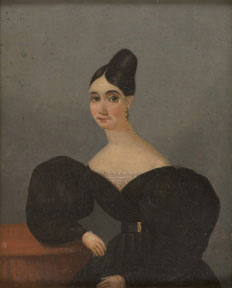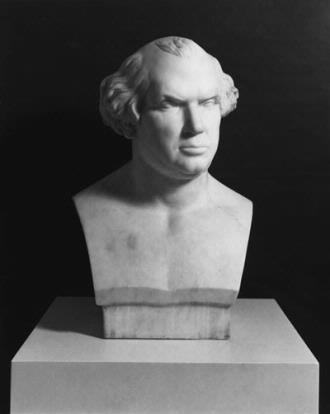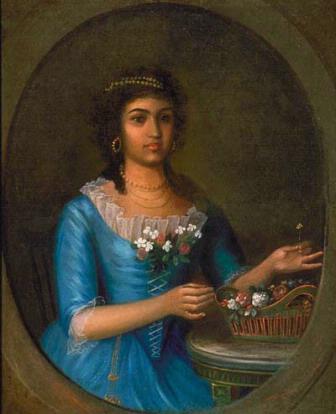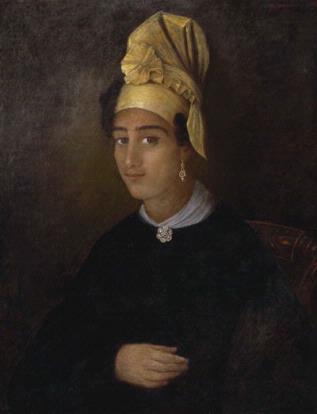
Hudson, 1811−1844
American
Portrait of a Man, Called a Self-Portrait
1839
oil on canvas
Collections of the Louisiana State Museum, 07526B
Long believed to be a self-portrait, this painting has been championed as one of the earliest such examples by an artist of African descent in the United States. But this interpretation rests on unstable ground. It was not until 1938, 94 years after the artist’s death, that the painting was declared a self-portrait by amateur art journalist Ethel Hutson, who declared that “[h]is self-portrait shows pronounced Jewish as well as Negroid characters.” Hutson provided no factual basis for her identification; nor has subsequent research turned up any evidence to indicate where she might have obtained her information. (Its previous owner, Dr. Isaac Monroe Cline, one of the earliest significant Louisiana art collectors, labeled the portrait simply as “a man.”)
Whoever the sitter, the painting reveals Hudson’s confidence in evoking his subject’s personality and dramatic features and in showcasing detail, from the patterned waistcoat to the fictive stone surround framing this enigmatic young man.

Hudson
American, 1811-1844
Portrait of a Lady, 1835
Oil on canvas over panel
M.F. Collection
This small, signed and dated portrait of a woman was recently discovered in a private collection, making it the sixth-known surviving portrait by Julien Hudson. Its small scale is reminiscent of his other works, while the direct gaze of his unknown, fashionably dressed sitter is reminiscent of the eye contact maintained by the sitters of the Creole Boy with a Butterfly and Portrait of a Man, called a Self-Portrait.

Eugène Warburg, 1825 or 1826−1859
American
John Young Mason
1855
marble
The Virginia Historical Society, Richmond, Virginia, 1927.21
This classical portrait bust was sculpted in Europe, where long-time Virginia politician and public servant John Young Mason was serving as United States minister to France. Mason’s colleague Victor Soulé, the minister to Spain, arranged the commission as a favor to Eugène Warburg, a free man of color from New Orleans who had gone to Paris in search of greater artistic opportunities. Soulé was a close friend of the sculptor’s father, Daniel Warburg, a German Jew who had immigrated to New Orleans, where he became a commission merchant and real estate speculator.

attributed to the School of José Francisco Xavier de Salazar y Mendoza,
about 1750−1802
Spanish, born Mexico, active Louisiana
Marianne Celeste Dragon
about 1795
oil on canvas
Collections of the Louisiana State Museum, gift of John T. Block, 05750
This portrait is one of the oldest works made in Spanish colonial Louisiana. It constructs its young sitter Marianne Celeste Dragon as both marriageable and exquisitely French, from her sumptuous blue satin robe à la française to her pearl-encrusted hair, dressed à la hérisson (in the “hedgehog” style), to the marble-topped gueridon—probably imported—at which she sits. Yet Dragon was mixed-race, born to a Greek immigrant father, who was a soldier and slave trader, and Françoise Monplaisir, a New Orleans free woman of color. After her 1799 marriage to André Dimitry (also a Greek immigrant), Dragon passed as white. But in 1853, during a bitter dispute over her grandson George Pandelly’s election to city government, his opponent Victor Wiltz exposed the family’s matrilineal African ancestry.

François (Franz) Fleischbein, 1801 or 1803−1868
American, born Bavaria
Portrait of Betsy
1837
oil on canvas
The Historic New Orleans Collection, 1985.212
Thought to be a portrait of François Fleischbein’s housekeeper, this painting displays the artist’s tendency to represent sitters in a three-quarter profile view. His sitters often look out at the viewer with a sideways glance and a pleasant, inquisitive expression. Fleischbein emphasizes Betsy’s elaborate, high tignon, the hair covering mandated for women of color after 1785. Although her features and skin tone suggest mixed ancestry, legal records do not indicate whether Betsy was an enslaved or free domestic servant.
Bavarian-born Fleischbein studied in Paris with the esteemed neoclassical painter Anne-Louis Girodet-Trioson. Beginning in 1833 Fleischbein followed the example of his classmate Jean-Joseph Vaudechamp, seeking artistic opportunities among New Orleans’s wealthy planters and merchants.


